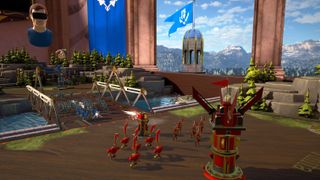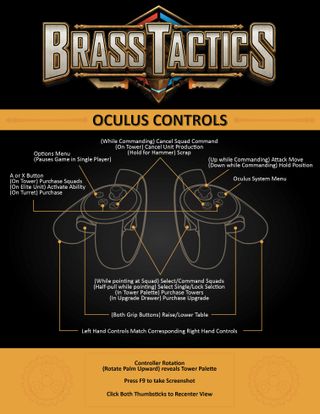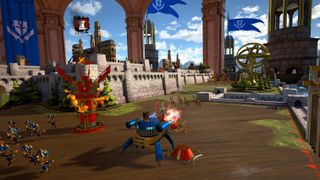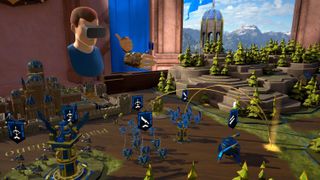Benchmarking Oculus' Not-So-Exclusive 'Brass Tactics'

Hidden Path Entertainment’s Brass Tactics is finally available. We first encountered the game in February 2017, and even then, the game felt polished and nearly ready for prime time. The developer originally planned to launch the game in October, and it went so far as to open pre-orders in September. Shortly before launch, however, Oculus stepped in and asked Hidden Path to “take the game to the next level.”
Oculus gave Hidden Path Entertainment additional funding to add more content to the game. Despite being in the final stages of development, the developer agreed to delay the release because the extra time and funds allowed it to bring back some of the ideas it had cast aside. Hidden Path used the resources to create a slew of extra units that wouldn’t have shipped in the original build, for example, and make other improvements.
Well Optimized Performance
Hidden Path Entertainment also used the extra time to tune the graphics for better performance and achieve higher fidelity for higher-end hardware. Patrick Moynihan, Studio Art Director at Hidden Path, told us that the build meant for release last fall featured baseline graphics settings equal to the current game’s low settings. The build released to consumers offers low, medium, high, and ultra presets. Moynihan said:
“The higher quality settings improve LOD distances, particle detail, animation quality, shadow quality, anti-aliasing, and pixel density. We really made an effort to determine what the most popular VR system configurations were, and created presets based around those performance profiles,” said Moynihan. “On a decent i7 processor with a 1080 GPU, it’s possible to play at 90fps even on the Ultra settings with all the bells and whistles enabled.”

Moynihan also provided a screenshot that shows the company’s internal test results. The green line represents the low quality settings, which can achieve 90fps on minimum specification hardware. The graphs also show how the medium (blue), high (orange), and ultra (pink) presets affect performance, and as you can see, anything higher than low settings is too much for a minimum spec VR system.
Our VR test system offers far higher performance than a minimum specification PC. It features a six-core Intel Core i7-5930K and a Gigabyte GTX 980Ti Xtreme, which puts it on the higher-end but not bleeding edge. We noticed a few hitches while playing Brass Tactics at ultra settings, but it worked well on high settings. Hidden Path said a GTX 1080 with a modern i7 should handle Ultra without a problem.
Hidden Path demonstrated that the game operates well on the Rift headset, which it's intended for. However, we wanted to explore how well the game's optimizations scale to higher resolutions. The Oculus Rift HMD features 2160x1200 pixels, which is good enough to produce fairly clear visuals. However, the 2880x1440 and 2880x1600 panels found in Windows Mixed Reality headsets and the upcoming Vive Pro HMD provide a clearer image.
Stay on the Cutting Edge
Join the experts who read Tom's Hardware for the inside track on enthusiast PC tech news — and have for over 25 years. We'll send breaking news and in-depth reviews of CPUs, GPUs, AI, maker hardware and more straight to your inbox.
Before we could test Brass Tactics at higher resolution, we had to figure out if it's even possible to play the game on other headsets.
Oculus Exclusive, Or Is It?
Brass Tactics is an Oculus exclusive title. Hidden Path Entertainment doesn’t currently have plans to bring the game to other VR platforms, and when we asked Brass Tactics lead designer Patrick Lipo and associate producer Lee Resenberg if they had tested the game on other HMDs, they said no. That doesn’t mean you can’t play Brass Tactics with another HMD, though. Even during our early-access preview of Brass Tactics, we were able to get the game working with the popular ReVive injection software to play it with other headsets.
We tried to test Brass Tactics with our Vive HMD, but the control mapping doesn't work. The Vive controller doesn’t have the correct inputs to cover every function in the game, and unfortunately a critical function is missing. You must press the A button to deploy troops and build guard towers and the Vive wands don't have face buttons to emulate that input.
The mapping for the Windows MR controllers is perfect, though. The thumbstick, trigger, and the grip buttons map directly, and the menu buttons work as you would expect. The Windows Mixed Reality motion controllers don’t have A, B, X, and Y buttons, but the trackpad emulates the missing inputs. We spent as much time playing the game with our Windows MR headset as we did with the Oculus Rift headset, and it worked wonderfully.
FCAT VR
Once we had the game running on our Windows MR HMD, the next step was to see if FCAT VR would work. Officially, FCAT VR does not support Windows MR headsets, which explains why the original version of FCAT VR didn't work with our Acer Windows Mixed Reality HMD. Nvidia said it's working to support Windows MR, however, and the company recently sent us a newer build that seems to work with Windows MR via Steam VR.
We ran four tests per headset; one for each graphics setting, all on the same host system.






As you can see from the results, the ultra preset demanded more performance than our GTX 980 Ti could deliver. We observed a significant number of dropped frames. Our test system handled the the high preset well with the Rift headset, but with the Odyssey headset we still lost frames. With the higher resolution and the extra software running in the background (Windows Mixed Reality Portal and ReVive), we're not surprised that we observed a few lost frames.
The Odyssey headset works better when you turn the graphics down to medium or below. At the medium preset, the system still struggled to deliver buttery smooth frame times. However, the dips were not apparent from inside the headset. We achieved more stable performance on the low setting, but we would prefer the visual fidelity of medium and the occasional lost frame over the lowest graphics settings and now performance dips.
Tabletop Gameplay
Hidden Path designed Brass Tactics specifically for virtual reality. The company borrowed elements from classic RTS video games, such as Age of Empires, and table-top RTS games, such as Games Workshop’s Warhammer series. Brass Tactics is played on a virtual tabletop known as the War Table. Two players control castles at opposing sides of the battlefield, and the goal is to wipe out the other player’s army and property to take control of their kingdom.

Like any RTS game, Brass Tactics relies on resource management. You must collect ore and gems so you can construct towers and deploy units for your army. In the beginning, you have access to Level One units, such as Warriors, Archers, and Cavalry. You must level up your castle by securing territory and increasing your resource production to gain access to stronger units.
Unlike most RTS games, fog of war is not a feature in Brass Tactics. From the moment you approach the War Table, you can see the entire map in front of you. You start behind your castle, but you can move around to get a better view of the terrain. To move around the map, reach out with your Touch controller and squeeze the grip button to latch onto the table. While holding onto the table, you can pull yourself in any direction. Give the table a hard tug to send yourself across the map quickly.
Brass Tactics also includes a simple mechanic to adjust the table height. Grab the table with both controllers to move it up or down. You can adjust the table height at any time during gameplay, which allows you to easily transition from a standing to a seated position. You can also recenter your view on the fly by pressing both thumbstick buttons simultaneously.

Simplified Strategy
Real-time strategy games are often complex, with nested menus that include dozens of units to unlock and master. Hidden Path Entertainment said that it didn’t want to bring all these complexities into a VR game, so it distilled the genre's common features into more simplistic forms.

Hidden Path Entertainment boiled down the classic RTS game to the bare essentials not to simplify the game, but to shorten each round. The matches in some RTS games can stretch to an hour or more, and the developer worried that an hour would be too much time in a VR match. Hidden Path believes that 20 to 30-minutes is the ideal length of time for a battle, so each mission is tailored to that timeframe.
To gain control of a region, you must push the enemy out and then install a tower. Once you have a tower, the region becomes part of your kingdom, and you receive the ore and gems mined in that area. You must have the resources on hand to construct buildings, but you don’t need to send construction workers in to build the towers. Newly created buildings activate within seconds.
Brass Tactics offers more than a dozen units to master, and it features more than 20 maps to take control of, but you won’t find any menus on the War Table. To access the list of available buildings, simple turn your hand over and look at your palm. A window will appear with each available tower that you can grab with your other hand. Once your tower is built, you can point at it and press the A button to queue it up to build units for your army.

In addition to housing the building menu, your hands also provide details about your resources and unit deployment. Here you can see how many gems you have, how many you’ll receive in the next delivery, and how long until you receive them. It also shows you how much ore you have stockpiled, how many units you have deployed, and the maximum number of units that you can command.
Start With The Campaign
Real Time Strategy games have never been our forte, and Brass Tactics isn’t kind to our newb-ish abilities. Despite giving it more than a half-dozen attempts, we were unable to complete the first solo mission. Every time we thought we had the upper hand, our opponent, Princeps Zavolto, would toss an insult our way and proceed to pummel our troops with contraptions and machinery that we never could seem to unlock.

After speaking with Hidden Path Entertainment, we learned that we were doing it wrong. The developer said the Solo missions are meant for players who are well versed in the controls and mechanics of the game but would rather fight an AI opponent than another human player. To get you accustomed to Brass Tactics and its intricacies, you should play the campaign first. Each of the eight levels teaches you a valuable lesson about how to play effectively. Once you’re competent enough to beat the final mission in the campaign, you should be equipped to handle a full-fledged AI opponent in Solo or another human in an online match.
The training that you receive in the campaign missions gives you invaluable tactical knowledge that can even the playing field, such as which units to send in against a group of warriors and which units are more effective against archers.
Defensive, Offensive, Balanced Loadouts
Brass Tactics features multiple loadouts that suit different play styles. By default, the game is set to Balanced, which gives you an even spread of offensive and defensive units to deploy. The Balanced loadout allows you to take on offensive and defensive challenges, though it doesn’t excel in either discipline.

The game also offers an Aggressive loadout, which offers stronger attack units, with limited defenses. The Defensive loadout includes units that can take more of a beating, but they can’t dish out as much damage. You can also create custom loadouts to suit your play style better once you get the hang of the game. Hidden Path included three custom slots to populate.
Customized loadouts give you control over which class of units you would like to deploy. However, you don’t get free reign to select only the best of the best. Each loadout page includes three tiers of units, which you can access by upgrading your castle’s level.
Level One slots support the Warriors, Archers, Cavalry, or Scouts. Level Two features five slots, which support stronger units, such as tanks and artillery. Every loadout also gets either a Titan or an Airship, which unlocks when you get your castle to level three. The Level Three units are expensive and difficult to build, but if you manage to get one into the battle, you’ll have a serious advantage over your enemy.
Hollywood Actors
Hidden Path Entertainment started marketing Brass Tactics a year ago, but somehow it neglected to advertise that it hired some well-established actors to voice the characters. We found the details in a post from the developer on Reddit.
Aidan Gillen, best known for his portrayal of Littlefinger in "Game of Thrones," embodies the primary villain Princeps Zavolto. You’ll encounter him regularly throughout the game, and he’ll toss insults your way at every chance he gets. There’s nothing quite like being called a “dogfart” or a “sniveling scum sack” by a weasel like Littlefinger while losing in battle to make you feel like a pathetic commander.



Along with Gillen, Hidden Path brought in the Oscar nominated Shoohreh Aghdashloo to portray one of your enemies. Aghdashloo has one of the most distinct voices in show business, and we knew it was her the moment her character spoke for the first time. Aghdashloo’s character is a powerful, ruthless foe. And she chants “buzz, buzz” to taunt you while she makes aerial attacks that rain bombs on your towers.
Brass Tactics also features a handful of professional voice actors, including Ike Amadi, who voiced characters for several video games, including Middle-Earth: Shadow of War, Dishonored: Death of the Outsider, Farpoint, and Mass Effect: Andromeda, among others. Christopher Swindle, who voiced characters in Lego Dimensions, Disney Infinity, and Transformers: Devastation also lends his talents to Brass Tactics' cast.
Try The Game For Free, Unlock The Full Game For A Fee
Brass Tactics is available on the Oculus Store for $40, but if that’s too rich for your blood, you can play an abridged version of the game for free. Last week, Hidden Path Entertainment released Brass Tactics Arena, which offers players a taste of the full game. Brass Tactics Arena features a single map and allows unlimited online play, including against people with the full game, as well as solo play against an AI opponent.
Kevin Carbotte is a contributing writer for Tom's Hardware who primarily covers VR and AR hardware. He has been writing for us for more than four years.
-
scheeseman ReVive maps all the important functions of the Touch controllers to the Vive wand including the buttons, though it can be a bit awkward to press them. The buttons are mapped to the bottom-inner corner of each touchpad, think of it as virtualizing the Touch's layout, emulating the placement of the stick and buttons.Reply
Most Popular


